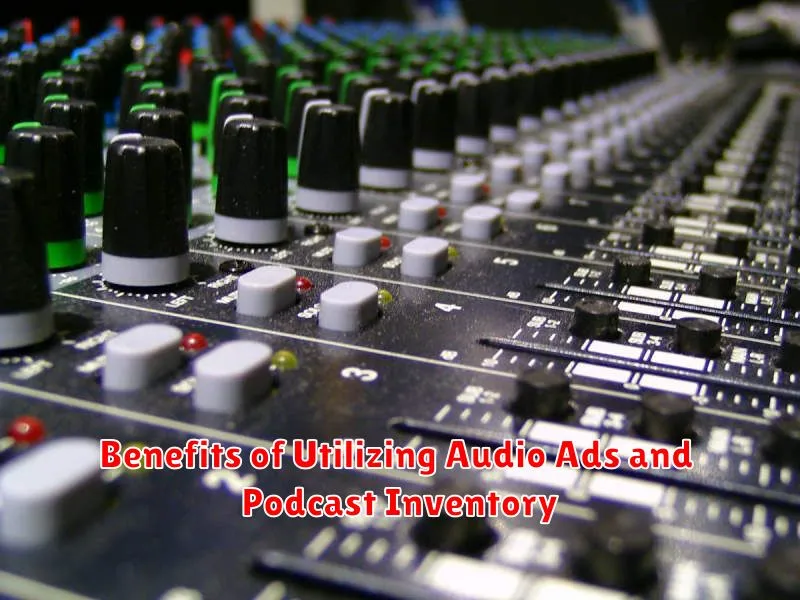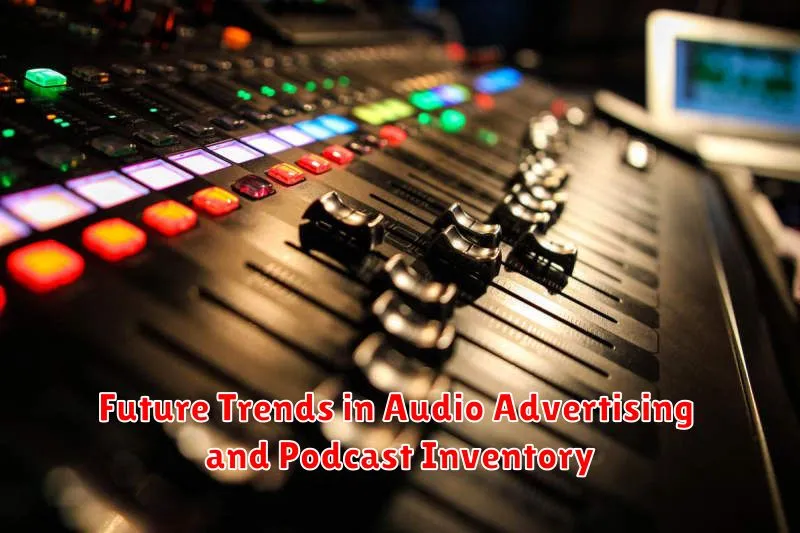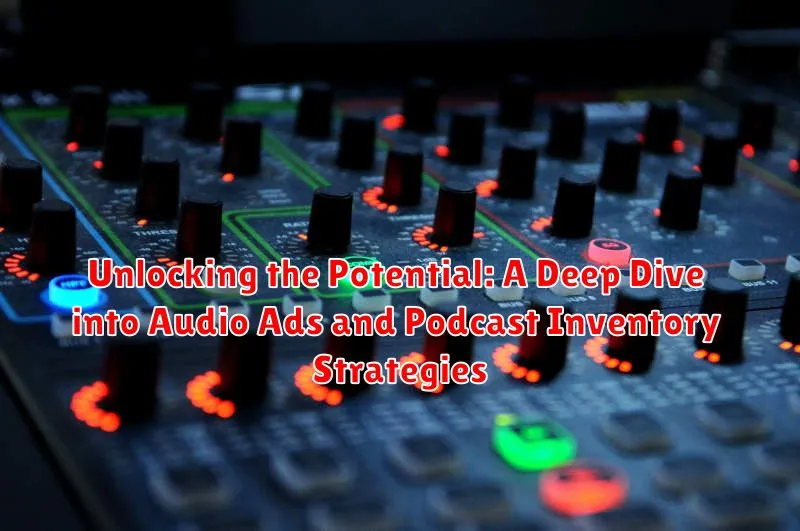In today’s increasingly digital world, businesses are constantly seeking innovative and effective advertising strategies to reach their target audiences. Among the plethora of options available, audio ads and podcast inventory have emerged as powerful tools for connecting with consumers in a personalized and engaging manner. This article, “Unlocking the Potential: A Deep Dive into Audio Ads and Podcast Inventory Strategies,” will provide a comprehensive exploration of this dynamic landscape, examining the benefits, challenges, and best practices for leveraging audio advertising to its full potential. We will delve into the nuances of the audio advertising ecosystem, addressing key aspects such as targeting, creative execution, measurement, and optimization.
This detailed analysis will go beyond surface-level observations, providing actionable insights for both seasoned marketers and those new to the realm of audio advertising. We will examine the growth of podcast listening globally, the increasing sophistication of audio ad technology, and the diverse range of opportunities available for brands to connect with their audiences through audio. By understanding the strategic considerations involved in crafting successful audio ad campaigns and navigating the complexities of podcast inventory, businesses can unlock significant value and achieve measurable results. Prepare to discover how audio ads can elevate your advertising efforts and drive meaningful engagement with your target demographic.
What Exactly are Audio Ads and Podcast Inventory?
In the realm of digital advertising, audio ads represent a potent medium for reaching audiences through sound. Specifically, audio ads are advertisements delivered to listeners through various digital audio platforms.
These platforms include streaming music services like Spotify and Pandora, internet radio stations, and of course, podcasts. Formats can range from short, pre-recorded messages (pre-roll, mid-roll, post-roll) to interactive audio experiences.
Podcast inventory refers to the available advertising space within podcasts. This “inventory” is sold to advertisers who wish to reach the podcast’s audience. Podcast inventory is often sold based on CPM (cost per mille, or cost per thousand listeners) or on a sponsorship basis.
Understanding both audio ads, and especially podcast inventory, is key to running an effective digital advertising campaign.
The Growing Popularity of Audio Advertising
Audio advertising is experiencing a significant surge in popularity, driven by several key factors. Increased smartphone penetration and the widespread adoption of wireless headphones have made audio content more accessible than ever before.
The rise of podcasting has also contributed significantly. With a diverse range of genres and topics available, podcasts attract a highly engaged audience, making them an attractive platform for advertisers.
Furthermore, audio ads offer a non-intrusive way to reach consumers. Unlike visual ads that demand attention, audio ads can be passively consumed while individuals are engaged in other activities, such as commuting, exercising, or working.
The effectiveness of audio advertising is further amplified by its ability to target specific demographics and interests, delivering relevant messages to the right audiences.
Different Types of Audio Ads Available
The audio advertising landscape offers a variety of formats, each with its own strengths and optimal use cases. Understanding these distinctions is crucial for crafting effective campaigns.
Common Audio Ad Formats:
- Pre-roll Ads: Played at the beginning of a podcast episode or audio stream. They benefit from high listener attention.
- Mid-roll Ads: Inserted during a break in the content. These often perform well due to listener engagement.
- Post-roll Ads: Played at the end of the content. They are a less intrusive option.
- Sponsorship Ads: Involve a deeper level of integration with the content creator or platform, often featuring mentions or dedicated segments.
- Companion Display Ads: Visual banners that accompany the audio ad on streaming platforms, offering a supplementary visual element.
Each format provides unique opportunities for messaging and targeting, and the ideal choice will depend on the specific campaign goals and budget.
Understanding Podcast Inventory: What’s on Offer?
Podcast inventory refers to the available advertising space within podcasts that marketers can purchase to reach their target audience. This inventory is not a monolithic entity; rather, it encompasses a variety of ad formats and placement options, each offering unique advantages.
Types of Podcast Inventory:
- Pre-roll Ads: These ads play at the beginning of a podcast episode. They offer high visibility as listeners are typically engaged and attentive at the start.
- Mid-roll Ads: Inserted during the podcast content, these ads can provide a less intrusive experience if integrated seamlessly with the discussion.
- Post-roll Ads: Placed at the end of the episode, post-roll ads may reach a more committed audience who have listened to the entire show.
- Host-Read Ads: Delivered by the podcast host themselves, these ads often benefit from the host’s credibility and rapport with their audience.
- Sponsorships: Involve a deeper level of integration, where a brand sponsors an entire episode or a series of episodes, often with recurring mentions and branding opportunities.
The specific inventory available varies depending on the podcast network or platform, the individual podcast’s popularity, and the advertising agreements in place. Understanding these different options is crucial for crafting effective and targeted audio advertising campaigns.
Benefits of Utilizing Audio Ads and Podcast Inventory

Leveraging audio ads and podcast inventory offers a multitude of advantages for businesses seeking to enhance their marketing strategies. These benefits span increased brand awareness, improved targeting capabilities, and cost-effective advertising solutions.
Enhanced Brand Awareness
Audio advertising allows for frequent and unobtrusive brand exposure, fostering familiarity and recognition among potential customers. Consistent messaging delivered through audio channels can significantly elevate brand recall.
Precise Audience Targeting
Podcast inventory, in particular, enables advertisers to target niche audiences based on specific interests and demographics. This granular targeting ensures that advertisements reach the most relevant listeners, maximizing impact and minimizing wasted impressions.
Cost-Effective Advertising
Compared to other advertising mediums, audio ads and podcast sponsorships often present a more affordable option, especially for businesses with limited marketing budgets. The efficiency of reaching a highly targeted audience translates to a greater return on investment.
Non-Intrusive Engagement
Audio advertising seamlessly integrates into listeners’ daily routines, offering a less intrusive alternative to visual ads. This format allows consumers to passively absorb information while engaging in other activities, enhancing receptiveness to marketing messages.
Targeting Strategies for Audio Ads and Podcasts
Effective targeting is crucial for maximizing the impact of audio ads and podcast inventory. Several strategies can be employed to reach the desired audience.
Demographic Targeting
This involves targeting listeners based on age, gender, location, income, and education level. Many platforms offer precise demographic targeting options.
Interest-Based Targeting
Interest-based targeting allows advertisers to reach listeners based on their hobbies, interests, and passions. This can be achieved by analyzing listening habits and content preferences.
Contextual Targeting
Contextual targeting involves placing ads within podcasts or audio content that is relevant to the product or service being advertised. This ensures that the ad is seen by an audience that is already interested in the topic.
Behavioral Targeting
This targeting method leverages data on past listener behavior, such as website visits and purchase history, to serve more relevant ads. First-party and third-party data can be utilized to refine targeting parameters.
Measuring the Success of Your Audio Ad Campaigns
Measuring the effectiveness of audio ad campaigns is crucial for optimizing your strategy and ensuring a return on investment. Unlike traditional visual advertising, audio requires specific metrics to gauge its impact. Here’s how to approach it:
Key Performance Indicators (KPIs)
Focus on KPIs such as impression volume, completion rate (how many listeners heard the entire ad), and click-through rate (CTR), especially if your ad includes a call to action directing listeners to a website.
Attribution Modeling
Employ attribution modeling to understand how audio ads contribute to conversions. This can be challenging but tools are available to help track the customer journey from ad exposure to a desired action, like a purchase.
Brand Lift Studies
Consider conducting brand lift studies to measure changes in brand awareness, perception, and recall after running an audio ad campaign. This involves surveying listeners both before and after exposure to the ads.
Website and App Analytics
Analyze your website and app analytics for increases in traffic or downloads that correlate with your audio ad campaign’s timeline. This can provide insights into direct response to your ads.
Key Considerations When Planning Your Audio Ad Strategy
Developing a successful audio ad strategy requires careful planning and consideration of several crucial factors. Neglecting these aspects can significantly impact the effectiveness of your campaigns and the return on investment.
Define Your Target Audience
Identifying your ideal listener is paramount. Consider demographics (age, gender, location), interests, and listening habits. This will inform your choice of podcasts and ad formats.
Set Clear Objectives
What do you hope to achieve with your audio ads? Are you aiming for brand awareness, driving website traffic, or generating leads? Clearly defined goals will guide your strategy and allow for accurate measurement of success.
Budget Allocation
Determine a realistic budget for your audio ad campaign. Consider the cost per mille (CPM) or cost per acquisition (CPA) for different podcast networks and ad formats. Allocate resources strategically based on your objectives and target audience.
Creative Execution
Craft compelling and engaging audio ads that resonate with your target audience. Consider using professional voiceover talent, music, and sound effects to create a memorable listening experience. Ensure your message is clear, concise, and aligned with your brand identity.
Future Trends in Audio Advertising and Podcast Inventory

The landscape of audio advertising and podcast inventory is poised for significant evolution. Expect to see further advancements in programmatic audio buying, allowing for more efficient and targeted ad placement.
Dynamic ad insertion (DAI) will become increasingly sophisticated, enabling hyper-personalized ads based on real-time listener data and contextual relevance. This enhances the user experience and maximizes ad effectiveness.
The rise of AI-powered audio creation and editing tools will democratize content creation, leading to an explosion of new podcasts and audio content. This expanded inventory will offer advertisers even more diverse opportunities.
Furthermore, expect increased integration of interactive audio ads, allowing listeners to engage directly with brands through voice commands or on-screen prompts (where applicable).
Finally, the development of more robust attribution models will provide clearer insights into the ROI of audio ad campaigns, justifying increased investment in this growing medium.

